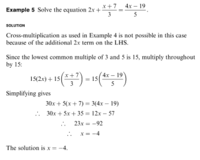CharlieDoggers
New member
- Joined
- Feb 14, 2021
- Messages
- 5
Hey guys,
Sorry for having to post two days in a row but I've been struggling a bit with this section in my textbook - as some of the examples they use to solve the equations are a bit unclear. With the exercise question in the textbook here:

the textbook example (found at the bottom of this post) first says that cross multiplication is not possible between the two values that are divisible by 4 and 2 respectively due to the other values of 6x and 4 on the LHS, and so it says that you need to find the lowest common multiple between 4 and 12, which is 12 in this case, and multiply it throughout the formula which should (I believe) result in this:
12(6x) +12(4) + 12(x - 2 / 4) = 12(14 - 9x / 12)
But this is where I get confused. I interpret the textbook example to have the two values simplified by dividing the bottom value of the fraction by the LCM on the outside bracket (which also makes me wonder why these values aren't applied to the rest of the equation). So simplifying 12(x - 2 / 4) to remove the 4 below the top (and vice versa the other side) will result in the formula:
72x + 48 + 3(x - 2) = 1(14 - 9x) and with my attempts to solve it results in the answer x = - 28 / 78 which is clearly wrong as the answer in the textbook says - 1 / 3 (lmao).
I just want to know what errors I've made in the entire process?
Any help would be greatly appreciated
Textbook example:

Sorry for having to post two days in a row but I've been struggling a bit with this section in my textbook - as some of the examples they use to solve the equations are a bit unclear. With the exercise question in the textbook here:
the textbook example (found at the bottom of this post) first says that cross multiplication is not possible between the two values that are divisible by 4 and 2 respectively due to the other values of 6x and 4 on the LHS, and so it says that you need to find the lowest common multiple between 4 and 12, which is 12 in this case, and multiply it throughout the formula which should (I believe) result in this:
12(6x) +12(4) + 12(x - 2 / 4) = 12(14 - 9x / 12)
But this is where I get confused. I interpret the textbook example to have the two values simplified by dividing the bottom value of the fraction by the LCM on the outside bracket (which also makes me wonder why these values aren't applied to the rest of the equation). So simplifying 12(x - 2 / 4) to remove the 4 below the top (and vice versa the other side) will result in the formula:
72x + 48 + 3(x - 2) = 1(14 - 9x) and with my attempts to solve it results in the answer x = - 28 / 78 which is clearly wrong as the answer in the textbook says - 1 / 3 (lmao).
I just want to know what errors I've made in the entire process?
Any help would be greatly appreciated
Textbook example:

